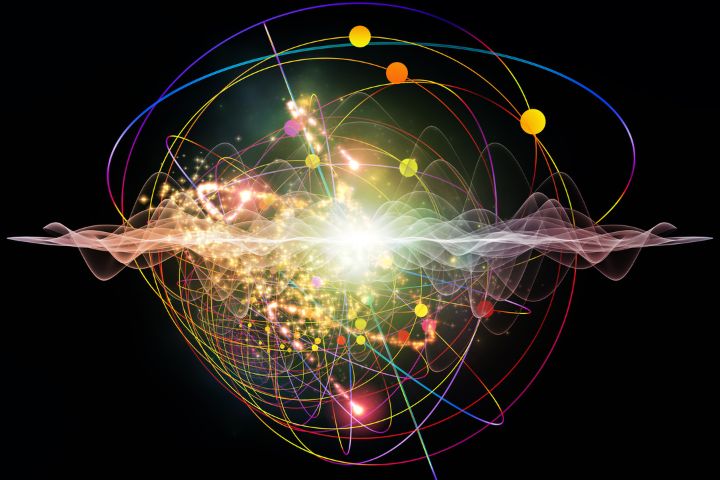What is quantum chromodynamics or QCD?

Quantum chromodynamics is a quantum field theory whose function is the study of the strong nuclear interaction. The strong nuclear force is responsible for keeping the nuclei of atoms (neutrons and protons) tightly bound, overcoming the electromagnetic force between protons.
Neutrons and protons are made of quarks. For example, protons are made up of two up quarks and one down quark and neutrons are made up of two down quarks and one up quark.
According to quantum field theory, the fundamental forces of the universe are a consequence of the exchange of bosons between particles. In the case of the strong interaction, these bosons are called gluons, a word that comes from the English “glue” which means glue. This exchange of gluons between quarks allows neutrons and protons to be tightly bound in the nucleus of the atom.
The word chromodynamics comes from the Greek chromos which means color. It is named after a conserved property of this type of quantum field called color charge. As we will see in the following sections, color charge is the quantum property that acts as glue to keep the nuclei of the atom well confined.
If you want to learn more about quantum you can read our complete article on quantum mechanics .
Today we will talk about
Asymptotic freedom in particle physics
In other quantum field theories, such as Feynman's quantum electrodynamics, the electromagnetic interaction loses strength as the distance between two electrons grows. That is, the closer two electrons are, the stronger the repulsive force between them.
The same thing happens with the gravitational force. How do we know from Newton's universal gravitation equation that the force of gravity is inversely proportional to the square of the distance. As a consequence, the gravitational interaction loses strength very quickly with the distance between two bodies.
In strong interaction, to everyone's surprise, the opposite occurs. When quarks are together, the strong nuclear force is very weak. But if we separate them it grows very quickly. To make a simile, it is as if the quarks were joined together with an elastic band. If they are very close together, the force exerted by said rubber is very low, but if you move them away, the rubber stretches and exerts a force that causes them to come back together.
Why does this phenomenon happen?
As we have said previously, the fundamental interactions occur through the exchange of bosons.
In electromagnetic interaction, these bosons are photons, and it turns out that photons do not interact with each other.
But in the case of the strong interaction, these bosons are gluons and the gluons can interact with each other, which gives quantum chromodynamics this property of asymptotic freedom.
Color charge in strong interaction
Quantum field theories describe fundamental forces and their symmetries. They are called gauge theories.
By Noether's theorem we know that a symmetry in a certain physical magnitude is equivalent to the conservation of that magnitude. For example, we know that energy is conserved, this is because there is a temporal symmetry.
We also know that linear momentum is a conserved property. The reason is because there is a translational symmetry.
Well, the same thing happens in gauge theories. If we take the function that describes the energy of the gluonic field (energy of the strong interaction), that is, its Lagrangian, we will see that it has certain symmetries.
This means that, if we apply this symmetry to the energy of the quantum field, this energy will not change, that is, it is invariant under this gauge transformation.
These symmetries are associated with a conserved magnitude, and this is neither more nor less than the color charge.
The color charge associates each quark with a different color. For example, in the case of protons we have two up quarks and one down quark. Each quark of a proton will have a different color: green, blue and red. If we mix these colors, we get white.
Conservation of color charge
The conservation of color charge tells us that, at all times, the set of three colors must give white.
For those of you who like mathematics, the set of these gauge symmetries of the gluonic quantum field forms a Lie group of special unitary matrices, called SU(3).
Mathematical formalism of QCD or quantum chromodynamics
In many quantum field theories, perturbative series are used to carry out calculations and predictions. Perturbative methods use a simple problem to solve and through perturbations the result of a more complex problem is obtained.
To calculate the parameters of the series, the famous Feynman diagrams are used. In quantum electrodynamics, the calculations are more precise since the gauge symmetry group has the property of being abelian (the elements of the group are commutative under the group operation). In contrast, the SU(3) group of quantum chromodynamics is non-Abelian.
For cases in which perturbative methods fail, other alternatives have been sought. Some examples are the formulation of quantum chromodynamics on the lattice or using the Ads/CFT (Anti-de-Sitter Conformational Field Theory) correspondence.
Atomic mass as a consequence of the gluon field
The property of mass is often associated with the Higgs boson. It is true that a part of the mass depends on how a particle couples to the Higgs field. For example, the top quark is the most massive quark since it couples more to the Higgs field.
However, a large part of the mass of protons and neutrons and, therefore, the mass of the atom is not due to the Higgs boson but to the gluonic field.
We have to imagine the nucleus of an atom as quarks and many gluons around it. This forms like a soup of gluons interacting with each other and with the quarks. All this energy from the gluon field is what gives most of the mass of the nuclei and not the Higgs field.

